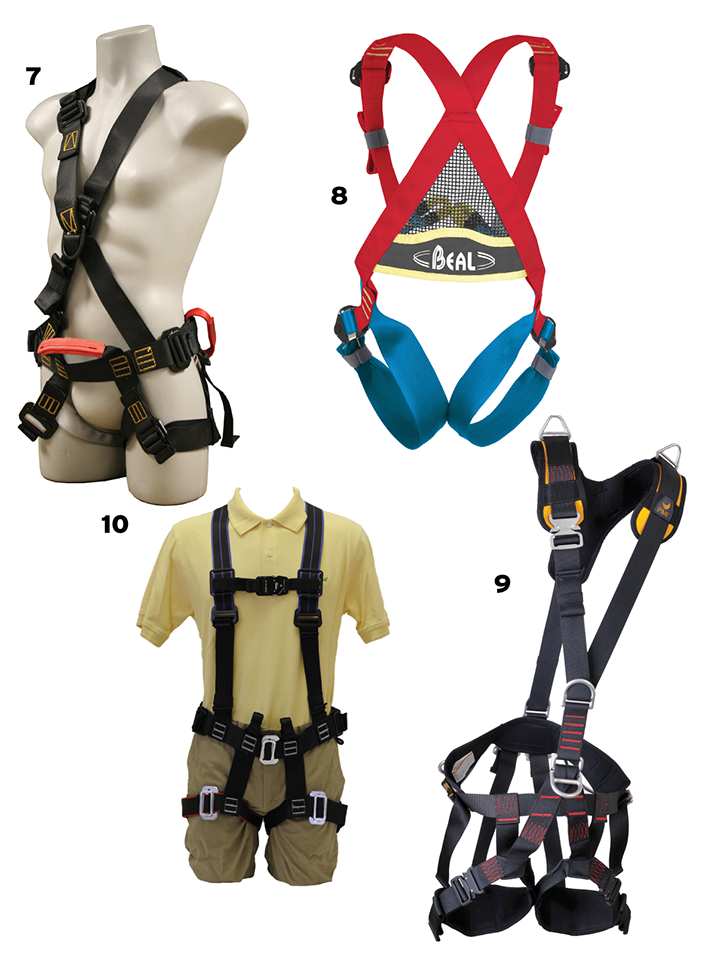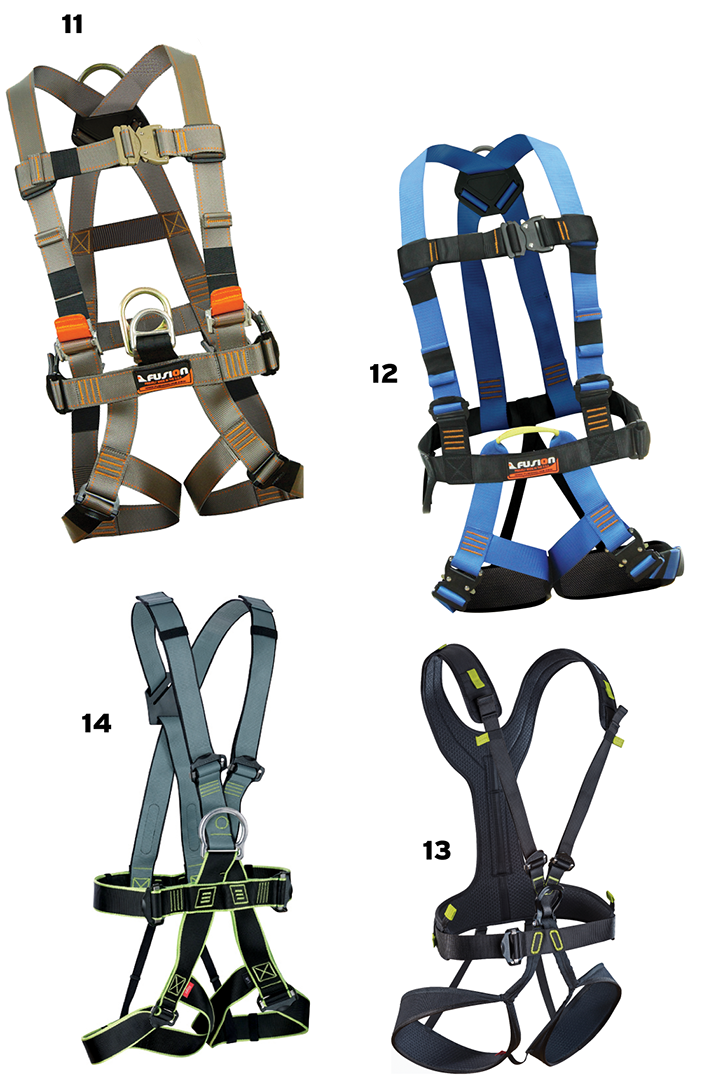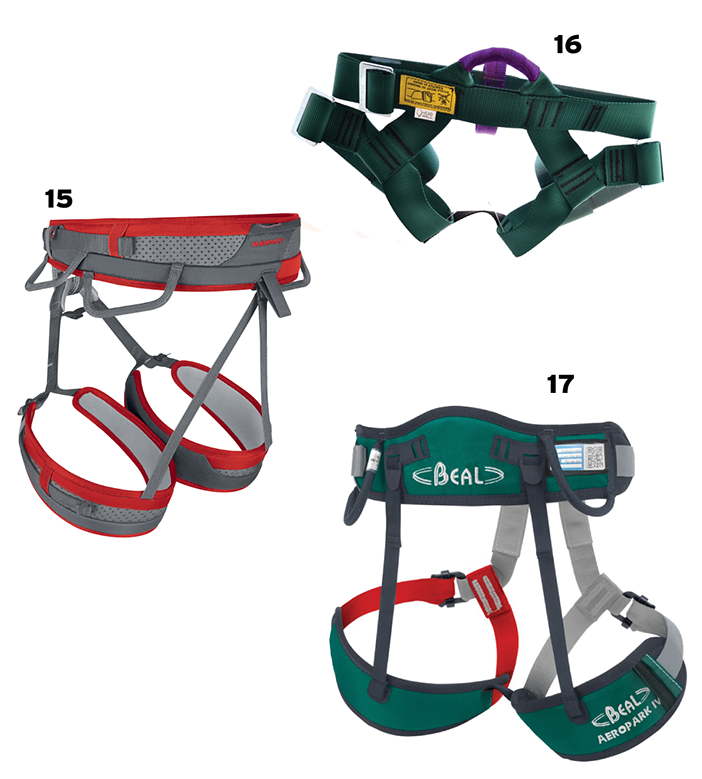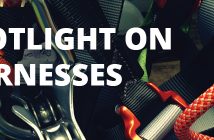It was more in line with what Adventureworks! founder Brian Lisson described in a Harness Standards Summary he wrote for the ACCT: “A harness is an arrangement of straps and fittings designed to connect a body to another object. The primary benefit of a harness is its ability to distribute forces across larger sections of the body than is possible with a direct connection point.”
The use of rock-climbing harnesses in the challenge course industry has been ubiquitous. The traditional sit (or seat) harness—which encompasses the waist and legs, and a geometry that causes the wearer to generally rest in a sitting position when hanging—is the mainstay. For particular elements where a participant could invert during the activity, a chest harness can be added to either prevent inversion or keep the participant from sliding out of the sit harness if they do invert—especially common for participants who carry their mass above their waist.
Evolving Needs
As the commercial aerial adventure industry blossomed, new technology, new apparatus, and new goals began to drive the search for different harness designs. And that’s good, since the variety of different activities and operations now requires an assortment of options.
Lisson addressed this in the Harness Standards Summary: “Harnesses for humans differ considerably based on their style (full body, seat, chest) and connection points (dorsal, sternal, waist, shoulder). This diversity reflects the variety of activities in which harnesses are used. … There are significant differences among harnesses—no single best harness exists. Instead, a suitable harness reflects the particular circumstances of the activity.”
So, in great measure, it was the uniqueness of newly emerging aerial adventure activities that drove some to look for new and different harness alternatives. Visionaries looked to other industries and recreational pursuits for inspiration. For instance, a harness originally designed for parasailing was modified by companies like ERi for use on long-span, high-tension zip lines, where rider comfort and proper rider orientation are important. And the harnesses used on hang gliders inspired the development of the “Superman” harness that allows a person to zip in a prone position.
Current Regulations
Very few regulatory bodies require the use of a specific harness type for participants. More often, regulators simply refer to a specific industry standard(s) regarding harness applications. Two of the most widely adopted standards in the aerial adventure industry are ANSI/ACCT 03-2016 and ASTM F2959-16.
The “Harnesses” section of the ANSI/ACCT 03-2016 standard covers five main topics: type, fit, strength, quality assurance, and inspection and evaluation. Each topic has a description of related requirements. For instance, “Fit: Harnesses shall be correctly sized and fitted based on the age, size, and body type of the individual.”
Others are more technical. “Strength” specifies minimum breaking strengths depending on the harness’ use. “Quality Assurance” lists several specific standards for which “Harnesses shall meet performance, construction and testing requirements of.”
The ASTM F2959-16 standard references a variety of other standards when addressing sizing, construction, and performance requirements for harnesses used as aerial adventure course equipment. (Read the harnesses portion of each standard in the full online story at adventureparkinsider.com.)
The standards state that the responsibility for choosing the appropriate harness for a given aerial adventure course or activity lies with the course or ride designer, or with another qualified person whose knowledge and expertise informs his or her ability to take all related factors into account and choose a harness that best meets the needs and requirements of that particular course or ride.
For this reason, an operator should always consult with the course designer/builder/manufacturer before even considering a change from the type of harness that was originally supplied. They will know if the different harness is appropriate for the application and whether it will create unanticipated issues or come with hidden risks.
Keep in mind, we are discussing participant or patron harnesses. Employee harnesses are governed by OSHA code, which mandates full-body harnesses for all employees working at height and provides specific allowances for harness connection points based on potential fall heights. Operators should know what OSHA requires for staff and implement procedures accordingly.
General Practice, Emerging Trends
So where are things going? In the U.S., at least, I expect to see a majority of commercial aerial adventure operations going to full-body harnesses for participants in the coming years. At our ZIPStream aerial adventure parks, we have always used a custom-made sit harness and supplemented with a chest harness for participants who need them. However, starting in 2017, our company will move to full-body harnesses for participants—for a number of reasons.
First, it takes the guesswork out of whether a person should be issued a chest harness based on his or her body type, thus eliminating the awkwardness of singling that person out.
Second, though some might disagree, I think full-body harnesses are, as a general rule, more secure. I have watched in horror as a participant’s sit harness slipped off his waist and fell to his feet as he stood on a high ropes course platform. Even a less-than-perfectly-fitted full-body harness will be far less likely to have that kind of issue.
Finally, I believe that the general public expects this standard of care for the types of activities we are engaged in. I’d rather not try to explain why we chose to use a harness that a participant could fall out of when a different, and potentially better, option existed.
One thing is for sure: Harnesses, along with the entire aerial adventure industry, will continue to evolve.
A look at the current market follows.
ZIP LINE-SPECIFIC HARNESSES
Deimos
1. Prone HD (Superman style)
A prone harness designed especially for high-speed zip lines, the Prone HD is available in one size and features six D-rings to allow for various rider angles, two quick release rear shoulder buckles, and half-inch foam padding. It is EN 1651 certified. Warranty: 1 year limited. Lifespan: 10 year retirement.
Weight: 1815 g. Price: $377.
2. Zip Standard
A seat harness designed for zip line use, it features step-in leg straps, waist buckle, and chest buckles. It is EN 1651 certified. Warranty: 1 year limited. Lifespan: 10 year retirement.
Weight: 1360 g. Price: $325.

FULL-BODY HARNESSES
Kong USA
3. Indiana Full
A full-body, universal-size harness featuring different color leg loops, six buckles for size adjustment, a wide aluminum D-ring at the waist to attach lanyards, and 44 mm webbing. It is certified CE 12277. Warranty: 3 years on manufacturer defects. Lifespan: 10 year retirement. Weight: 935 g.
Price: $218.
Misty Mountain
4. High Country Guide
A full-body harness designed for staff use, it features padded waist belt and leg loops, three cranked aluminum ISC D-ring attachment points (2 ventral, 1 dorsal), quick adjust steel alloy buckles, and two gear loops. Meets ASTM F-1772-12 standard. Warranty: Lifetime on materials and workmanship.
Lifespan: 5 years retirement after continuous service,
10 year retirement after manufacture.
Weight: 1361 g. Price: $250.
Liberty Mountain
5. Singing Rock Technic
A full-body harness featuring padded hip belt and leg loops, independently adjustable leg loops and shoulder straps, easy lock buckles for quick adjustment, and lightweight alloy D-rings. ANSI certified. Warranty: 3 year, plus 10 year limited. Lifespan: 10 years for sporadic use, 5 year retirement with daily use. Weight: 1620 g. Price: $150.
Adrenalin Gear U.S.A.
by FrenchCreek Production, Inc.
6. Full Body #4310
A full-body harness built for all-day use, it is constructed of 1 ¾-inch-wide 6,000-pound reflective webbing and features several attachment points; multiple waist, leg, and torso adjustments; fixed buckle connections; and padding on back/shoulder straps, lumbar, and legs. Warranty: 1 year limited. Lifespan: 5 year retirement. Weight: 1814 g. Price: $205.

7. Full Body #4330
A full-body, universal-size harness constructed of 1 ¾-inch-wide, 6000 lb. webbing. It features multiple waist, leg, and torso adjustments; fixed buckle connections; girth and front chest connection points. Warranty: 1 year limited. Lifespan: 5 year retirement. Weight: 1814 g. Price: $165.
SPS Filets
8. Beal Bambi II
A full-body harness designed for climbers that weigh less than 88 lbs., it features two automatic adjustment buckles on the leg loops and on the shoulder straps, color-coded body straps and leg loops, and four autolock buckles.
Warranty: 3 years. Lifespan: 15 years, 10 years in continuous use. Weight: 350 g. Price: $31.
PMI
9. Avatar Deluxe
A full-body harness designed for all-day use, it features AustriAlpin Cobra quick release, color-coded buckles; adjustable, integrated upper and lower harness sections; and spring-loaded buckle at dorsal and waist attachments. It meets NFPA 1983 and ANSI Z359.1 standards.
Warranty: 1 year on material and workmanship. Lifespan: Maximum potential lifetime is 10 years from the date of manufacture, regardless of history and use. Actual lifetime may be much shorter if the product doesn’t pass frequent and thorough inspections. Weight: 2721 g–2821 g.
Price: $510–$521.
Ropes Park Equipment
10. Quick IIIs
A full-body harness designed for participant use, it features step-in leg loops and easily adjustable straps, and comes in two color-coded sizes to assist park staff with sorting. It is EN 12277 Type C certified. Warranty: 1 year. Lifespan: 3-5 years based on usage. Weight: 1360 g–1587 g. Price: $165.

Fusion
11. Plemistis
A full-body harness designed for use in commercial zip line operations, it features three connection points, Presto steel buckle for the chest strap, and mesh-lined EVA foam padding on legs, waist, and shoulders. It meets ANSI Z359.1-2007 requirements. Warranty: Lifetime on workmanship and materials defects. Lifespan: 10 year retirement.
Weight: 907 g. Price: $195.
12. Streak Racer
A full-body harness designed for use in commercial zip line operations, it features a quick-release aluminum chest buckle, six adjustment points, and EVA foam padding on the leg loops. It meets ANSI Z359.1 requirements. Warranty: Lifetime on workmanship and materials defects. Lifespan: 10 year retirement. Weight: 816 g. Price: $95.
Edelrid
13. Radialis Pro
A full-body harness designed for aerial adventure park use, it features three “Easy Glider” buckles; padding on leg loops, shoulder, waist and back; and water-resistant outer fabric.
Warranty: 1 year. Lifespan: 10 years. Weight: 680 g–907 g. Price: $139.
14. Radialis Comp
A universal-size full-body harness, it features six “Easy-Glider” buckles, fully adjustable webbing construction, and multiple connection points. Warranty: 1 year. Lifespan: 10 years. Weight: 907 g. Price: $129.

SIT HARNESSES
Mammut
15. Ophir 4 Slide
A multi-purpose sit harness that features four “Slide Bloc” buckles, making it easy to adapt it to different body sizes; and two-part webbing that’s breatheable and allows the user freedom of movement. Warranty: EU Standard. Lifespan: 7 years in frequent use, 10 years from manufacture.
Weight: 470 g. Price: $70.
Headwall
16. Universal
A sit harness designed for use in challenge courses, it features rear attachment and the choice of a standard double-pass buckle or the EZ pull to adjust buckle system. The Universal harness is manufactured entirely in the U.S.A. Warranty: Lifetime on materials and workmanship. Lifespan: 10 year retirement. Weight: 340 g. Price: $38–$45.
SPS Filets
17. Beal Aeropark IV
A universal-size sit harness featuring a reinforced tie-in point, three autolock buckles and loosening paws, interlocked and color-coded thigh straps, and foam padding on waist and thigh straps. It is CE EN 12277 certified. Warranty: 3 years. Lifespan: 15 years, 10 years in continuous use. Weight: 400 g. Price: $33.

Petzl
18. Panji
A universal-size sit harness with a single tie-in point, it features protective tubing, DoubleBack buckles, narrow-webbing equipment loop, and webbing with different internal and external colors to help with donning and verification. It is CE EN 12277 type C, and UIAA 105 certified. Warranty: 3 years.
Lifespan: 10 year retirement. Weight: 460 g. Price: $80.
19. Falcon
A universal-size sit harness featuring a metal ventral attachment point (plus lateral and rear), semi-rigid waist belt and leg loops, and self-locking DoubleBack buckles. It can be turned into a full body by adding accessories. It is CE EN 358, CE EN 813, EAC certified. Warranty: 3 years. Lifespan: 10 year retirement. Weight: 840 g. Price: $185.
Kong USA
20. Indiana
A universal-size sit harness that can be used for climbing or as a seat harness for zip lining. It features fast-adjust buckles on the waist and leg loops and 4 mm webbing. It is certified CE 12277.
Warranty: 3 years on manufacturer defects. Lifespan: 10 year retirement. Weight: 350 g. Price: $75.58.
PMI
21. Alpine Backcountry
This mountaineering harness provides light weight, comfort, and adjustability. Quick-fit buckles at the waist and legs adjust for different layers of clothing and body types. Reinforced polyester resists abrasion. Other features: sliding waist belt, four gear loops, reflective trim, and elastic rear strap with quick release buckle. CE EN 12277 Type C certified; meets ASTM F1772 standards. Warranty: 1 year on material and workmanship. Lifespan: Maximum 10 years from the date of manufacture, regardless of history and use. Actual lifetime may be much shorter if the product doesn’t pass frequent and thorough inspections. Weight: 473 g. Price: $63.







